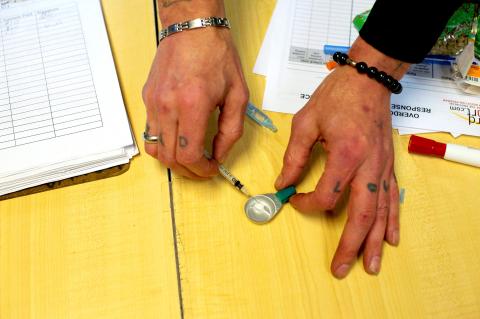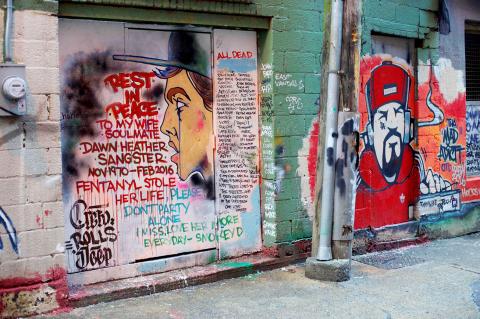Sirens scream non-stop through the urban heart of Vancouver, as responders race toward drug addicts overdosing — and dying in such numbers that the city’s morgues are full.
This wealthy Pacific coast city is the bleak epicenter of an opioid epidemic that has claimed thousands of lives in Canada, while next door in the US, drug overdoses are now the leading cause of accidental death.
“There’s not a single person down here that’s chosen to be a junkie,” said Martin Steward, a self-admitted drug user who manages a treatment facility in Vancouver’s gritty Downtown Eastside neighborhood where the crisis is concentrated. “Something happened in their lives: emotional, mental, physical, that brought them to where they are.”

Photo: AFP
On the neighborhood’s Hastings Street, blocks that were once bustling with people are now emptier.
“There are less and less of the people I know here,” said Mary Mootrey, who has lived in the area for 25 years, pointing to a few milling around. “They’ve all overdosed.”
Authorities in British Columbia predict that 2016 will break all records for provincial deaths from opioid overdoses, including 128 in November alone.

Photo: AFP
Officials had first declared an emergency in the spring, as cheap synthetic fentanyl replaced expensive heroin and soon became mixed into most street drugs.
A pill sells for as little as Can$2 (US$1.50), said the 59-year-old Mootrey. “I wish they’d all go into treatment,” she said of the many addicts in her neighborhood.
But treatment facilities are full, with long waits to get a spot.
“There’s always been a problem here,” said Steward, who manages a facility run by the Vancouver Area Network of Drug Users. “But now the morgue’s full, they look at it and say, we better do something.”
The 44-year-old has personal experience with addiction: a cocaine user by age 12, he eventually found himself living on the streets in Montreal.
Steward said he now uses cocaine and heroin, taking care to buy only from a known dealer and never injecting alone, in case he overdoses.
SKID ROW
For decades, the Downtown Eastside, or DTES, was where men broken by Canada’s resource booms ended up in cheap hotels, each with a pub on the ground floor.
Over time, they were joined by drug addicts from across Canada, and the mentally ill left homeless when British Columbia closed mental health institutions without providing community housing as promised.
“A lot of people here are under care, and targeted by drug dealers,” said Neil Arao, manager of Insite, North America’s only supervised injection site, located in the DTES. He estimated at least 1,200 locals are both mentally ill and addicted to drugs, though there are no accurate numbers.
Proposed solutions range from decriminalizing hard drugs to prescribing heroin to adding rehabilitation facilities.
Long term, experts and advocates agree, the solution is to reduce the numbers of drug users by solving issues that begin, for most, in childhood. That’s a challenge compounded by British Columbia’s child poverty rate of about 20 percent, one of the highest in North America.
‘LIKE A TRAP’
The acute poverty and despair in the DTES is a shocking sight in the heart of Vancouver, an otherwise bustling and wealthy metropolis where average home prices are nearly Can$1 million, according to the Canadian Real Estate Association.
It is “like a trap,” said Arao. “It’s hard to escape it.”
The numbers are stark. The Insite supervised injection center serves about 700 drug users a day, Arao said. In the past, one or two overdosed each day but in recent weeks it’s up to 15 per day.
The emergency room at St. Paul’s hospital has handled more than 6,000 overdose patients so far this year, said physician Nadia Fairbairn.
“Vancouver is right in the middle of the crisis,” she said.
In December, officials launched a mobile overdose clinic in the Downtown Eastside, staffed by emergency and addiction physicians.
Agencies have also set up rooms, and even tents in alleys, staffed by trained volunteers equipped with some 18,000 kits distributed by the government. Each contains injectable naloxone, which quickly counters the effect of most opioids.
Most policy experts agree there is little prospect for stopping the supply of cheap synthetic opioids. Authorities say most are shipped from China, and mixed in Canada with other drugs or pressed into pills.
Synthetic opioids are also available on the internet, with sites advertising discreet mail order shipments.
Asked to describe the situation, Arao said to call it a “crisis” implies there will be an end. “I’m wondering if this is now our normal,” he said.

On April 26, The Lancet published a letter from two doctors at Taichung-based China Medical University Hospital (CMUH) warning that “Taiwan’s Health Care System is on the Brink of Collapse.” The authors said that “Years of policy inaction and mismanagement of resources have led to the National Health Insurance system operating under unsustainable conditions.” The pushback was immediate. Errors in the paper were quickly identified and publicized, to discredit the authors (the hospital apologized). CNA reported that CMUH said the letter described Taiwan in 2021 as having 62 nurses per 10,000 people, when the correct number was 78 nurses per 10,000

May 5 to May 11 What started out as friction between Taiwanese students at Taichung First High School and a Japanese head cook escalated dramatically over the first two weeks of May 1927. It began on April 30 when the cook’s wife knew that lotus starch used in that night’s dinner had rat feces in it, but failed to inform staff until the meal was already prepared. The students believed that her silence was intentional, and filed a complaint. The school’s Japanese administrators sided with the cook’s family, dismissing the students as troublemakers and clamping down on their freedoms — with

As Donald Trump’s executive order in March led to the shuttering of Voice of America (VOA) — the global broadcaster whose roots date back to the fight against Nazi propaganda — he quickly attracted support from figures not used to aligning themselves with any US administration. Trump had ordered the US Agency for Global Media, the federal agency that funds VOA and other groups promoting independent journalism overseas, to be “eliminated to the maximum extent consistent with applicable law.” The decision suddenly halted programming in 49 languages to more than 425 million people. In Moscow, Margarita Simonyan, the hardline editor-in-chief of the

Six weeks before I embarked on a research mission in Kyoto, I was sitting alone at a bar counter in Melbourne. Next to me, a woman was bragging loudly to a friend: She, too, was heading to Kyoto, I quickly discerned. Except her trip was in four months. And she’d just pulled an all-nighter booking restaurant reservations. As I snooped on the conversation, I broke out in a sweat, panicking because I’d yet to secure a single table. Then I remembered: Eating well in Japan is absolutely not something to lose sleep over. It’s true that the best-known institutions book up faster